
The Battle of the Coral Sea, from 4 to 8 May 1942, was a major naval battle between the Imperial Japanese Navy (IJN) and naval and air forces of the United States and Australia. Taking place in the Pacific Theatre of World War II, the battle was the first naval action in which the opposing fleets neither sighted nor fired upon one another, attacking over the horizon from aircraft carriers instead. It was also the first military battle between two aircraft carriers.
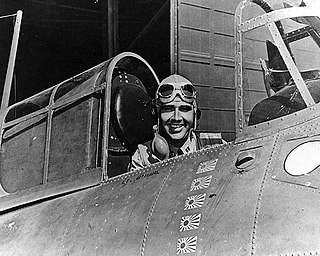
Lieutenant Commander Edward Henry O'Hare was an American naval aviator of the United States Navy, who on February 20, 1942, became the Navy's first fighter ace of the war when he single-handedly attacked a formation of nine medium bombers approaching his aircraft carrier. Even though he had a limited amount of ammunition, he was credited with shooting down five enemy bombers and became the first naval aviator recipient of the Medal of Honor in World War II.

The Brewster F2A Buffalo is an American fighter aircraft which saw service early in World War II. Designed and built by the Brewster Aeronautical Corporation, it was one of the first U.S. monoplanes with an arrestor hook and other modifications for aircraft carriers. The Buffalo won a competition against the Grumman F4F Wildcat in 1939 to become the U.S. Navy's first monoplane fighter aircraft. Although superior to the Grumman F3F biplane it replaced, and the early F4Fs, the Buffalo was largely obsolete when the United States entered the war, being unstable and overweight, especially when compared to the Japanese Mitsubishi A6M Zero.

The Thach weave is an aerial combat tactic that was developed by naval aviator John S. Thach and named by James H. Flatley of the United States Navy soon after the United States' entry into World War II.

Saburō Sakai was a Japanese naval aviator and flying ace of the Imperial Japanese Navy during World War II. Sakai had 28 aerial victories, including shared ones, according to official Japanese records, though he and his ghostwriter Martin Caidin claimed much higher numbers.
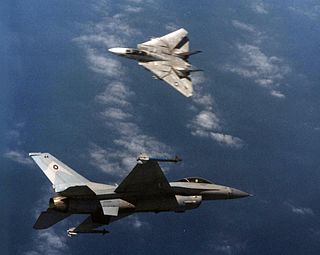
A dogfight, or dog fight, is an aerial battle between fighter aircraft that is conducted at close range. Modern terminology for air-to-air combat is air combat manoeuvring (ACM), which refers to tactical situations requiring the use of individual basic fighter maneuvers (BFM) to attack or evade one or more opponents. This differs from aerial warfare, which deals with the strategy involved in planning and executing various missions.
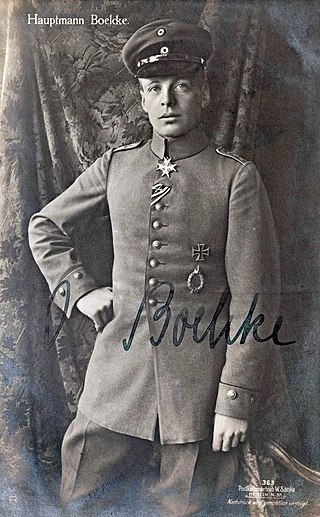
The Dicta Boelcke is a list of fundamental aerial maneuvers of aerial combat formulated by First World War German flying ace Oswald Boelcke. Equipped with one of the first fighter aircraft, Boelcke became Germany's foremost flying ace during 1915 and 1916. Because of his success in aerial combat and analytic mind, he was tasked by Colonel Hermann von der Lieth-Thomsen with writing a pamphlet on aerial tactics.
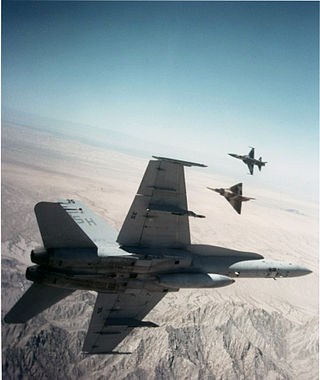
Air combat manoeuvring (ACM) is the tactic of moving, turning, and situating one's fighter aircraft in order to attain a position from which an attack can be made on another aircraft. Commonly associated with dogfighting, air combat manoeuvres rely on offensive and defensive basic fighter manoeuvring (BFM) to gain an advantage over an aerial opponent.

In aerobatics, the cobra maneuver, also called dynamic deceleration, among other names, is a dramatic and demanding maneuver in which an airplane flying at a moderate speed abruptly raises its nose momentarily to a vertical and slightly past vertical attitude, causing an extremely high angle of attack and making the plane into a full-body air brake, momentarily stalling the plane, before dropping back to normal position, during which the aircraft does not change effective altitude.
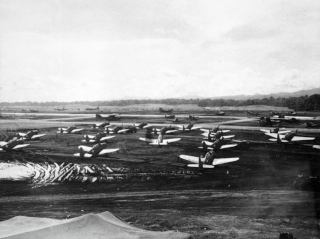
The Cactus Air Force was the ensemble of Allied air power assigned to the island of Guadalcanal from August 1942 until December 1942 during the most heavily contested phases of the Guadalcanal Campaign, particularly those operating from Henderson Field. The name is based on "Cactus", the Allied code name for the island. In 1943, the Cactus Air Force was absorbed into AirSols, a joint command of Allied air units in the Solomon Islands.

Basic fighter maneuvers (BFM) are tactical movements performed by fighter aircraft during air combat maneuvering, to gain a positional advantage over the opponent. BFM combines the fundamentals of aerodynamic flight and the geometry of pursuit, with the physics of managing the aircraft's energy-to-mass ratio, called its specific energy.
The scissors is an aerial dogfighting maneuver commonly used by military fighter pilots. It is primarily a defensive maneuver, used by an aircraft that is under attack. It consists of a series of short turns towards the attacking aircraft, slowing with each turn, in the hopes of forcing the attacker to overshoot. Performed properly, it can cause the attacking aircraft to move far enough in front to allow the defender to turn the tables and attack.

Lieutenant Junior Grade Tetsuzō Iwamoto was one of the top scoring aces among Imperial Japanese Navy Air Service (IJNAS) fighter pilots. He entered the Imperial Navy in 1934 and completed pilot training in December 1936. His first combat occurred over China in early 1938. He emerged as one of the top aces of the Imperial Japan during World War II, credited with at least 80 aerial victories, including 14 victories in China. Subsequently, he flew Zeros from the aircraft carrier Zuikaku from December 1941 to May 1942, including at the Battle of the Coral Sea. Iwamoto decorated his planes with victory markings of cherry blossom flowers, with a single or double blossom flower referring to a shot down enemy fighter or bomber aircraft respectively.
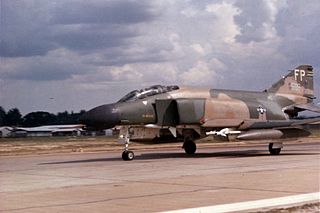
Operation Bolo was a United States Air Force mission during the Vietnam War, considered to be a successful combat ruse.
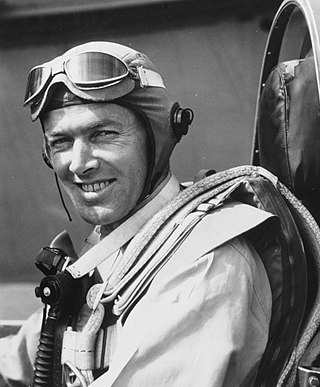
Vice Admiral James Henry Flatley Jr. was a World War II naval aviator and tactician for the United States Navy (USN). He became a fighter ace credited with shooting down six enemy aircraft in aerial combat.

The finger-four formation is a flight formation used by fighter aircraft. It consists of four aircraft, and four of these formations can be combined into a squadron formation.

The Akutan Zero, also known as Koga's Zero (古賀のゼロ) and the Aleutian Zero, was a Mitsubishi A6M2 Model 21 Zero Japanese fighter aircraft piloted by Petty Officer Tadayoshi Koga, that crash-landed on Akutan Island, Alaska Territory, during World War II. It was found intact by the Americans in July 1942 and became the first Zero acquired by the United States during the war that could be restored to airworthy condition. It was repaired and flown by American test pilots. As a result of information gained from these tests, American tacticians were able to devise ways to defeat the Zero, which was the Imperial Japanese Navy's primary fighter plane throughout the war.

Aerial ramming or air ramming is the ramming of one aircraft with another. It is a last-ditch tactic in air combat, sometimes used when all else has failed. Long before the invention of aircraft, ramming tactics in naval warfare and ground warfare were common. The first aerial ramming was performed by Pyotr Nesterov in 1914 during the First World War. In the early stages of World War II the tactic was employed by Soviet pilots, who called it taran (таран), the Russian word for "battering ram".
Kiyoto Furuta was a dive bomber pilot in the Imperial Japanese Navy (IJN) during World War II. He flew Aichi D3A dive bomber from carrier Akagi during the Attack on Pearl Harbor and the Indian Ocean Raid, and later from carrier Shōkaku in both carrier battles during Solomon Islands Campaign, where he scored bomb hits on United States Navy (USN) carrier Enterprise on two separate occasions.
Terufumi Kofukuda, born as Mitsugi Kofukuda, was an officer and a fighter pilot in the Imperial Japanese Navy (IJN) during World War II. He participated in various battles and campaigns throughout the Pacific War. After the war, he served in the new Japanese Self Defence Force (JSDF) as the commander of the Central Air Defense Force.
















